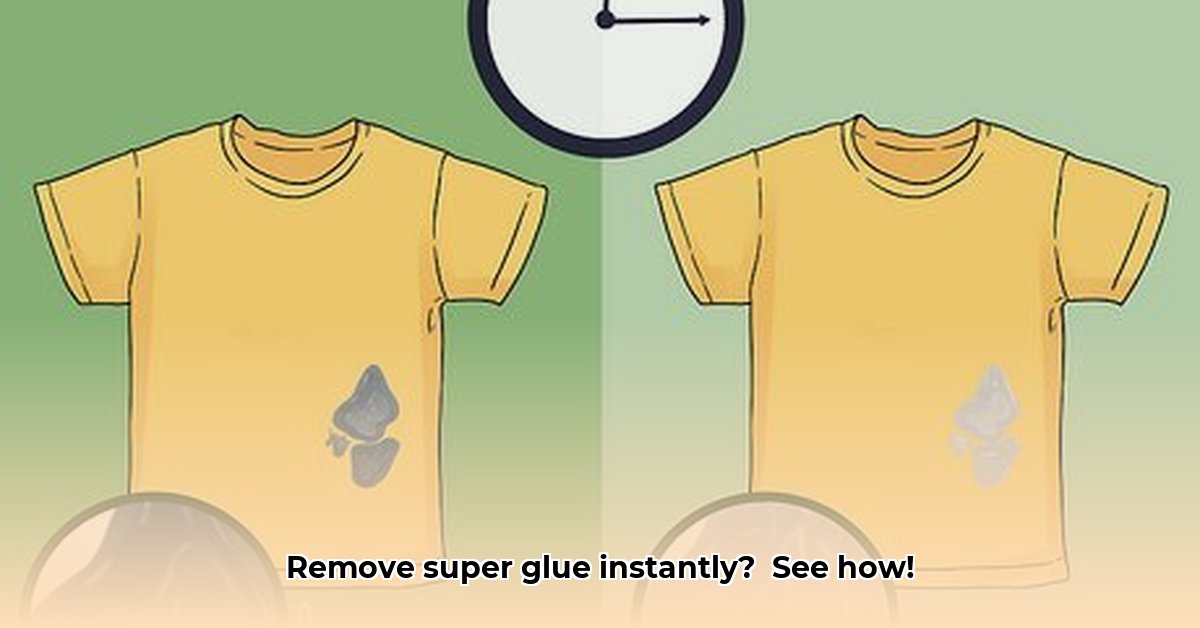Super glue: a DIY enthusiast’s best friend and worst nightmare. While invaluable for quick repairs, its bonding power becomes a menace when it comes into contact with clothing. This guide provides comprehensive, safe, and effective DIY methods for removing super glue from various fabrics, turning a potential clothing crisis into a manageable task.
Understanding the Enemy: Why Super Glue Removal Requires a Careful Approach
Super glue, or cyanoacrylate, forms incredibly strong bonds almost instantly. This rapid bonding is why it’s so effective for repairs, but also what makes it challenging to remove from fabric. Wet glue spreads easily, exacerbating the problem, while dried glue requires specific solvents to break its hold. Understanding this is the first step to successful removal.
Step 1: Assess the Damage and Fabric Type
Before attempting any removal method, carefully examine the affected garment. Identify the fabric type (cotton, denim, silk, wool, etc.), as this will determine the appropriate cleaning solution. Also, assess the extent of the glue spill—a small dot versus a large blob will require different approaches.
Step 2: The Freezing Method – A Powerful First Step
Freezing the garment can significantly improve your chances of successful glue removal. Place the affected item in a sealed plastic bag and freeze it for 1-2 hours. This hardens the glue, making it brittle and easier to dislodge. This technique is especially effective for thicker layers of glue, as the freezing process weakens the adhesive bond.
Step 3: Gentle Scraping – Precision Over Force
After freezing, use a dull-edged tool like a butter knife, credit card, or spoon to gently scrape away the hardened glue. Avoid sharp objects that could snag or damage the fabric. Think of this process as delicate surgery, not demolition.
Step 4: Solvent Selection and Application – Choosing the Right Tool for the Job
If scraping alone doesn’t remove all the glue, the next step involves solvents. It’s crucial to select the right solvent based on the fabric type:
- Acetone (Nail Polish Remover): Highly effective for durable fabrics like cotton, denim, and polyester. However, never use acetone on acetate, modacrylic, triacetate, silk, or wool, as it can melt or discolor these materials.
- Rubbing Alcohol (Isopropyl Alcohol): A gentler alternative to acetone, suitable for more delicate fabrics. It may take longer to work, but is less likely to cause damage. Diluting the alcohol with water can further minimize the risk.
- White Vinegar: A surprisingly effective and gentle option, safe for most fabrics. Soaking the stained area in vinegar for 30 minutes can help loosen the glue’s bond.
Application: Always test any solvent on an inconspicuous area first. Apply the chosen solvent with a cotton ball, dabbing gently from the outside of the stain inwards to prevent spreading.
Step 5: Post-Solvent Treatment – Ensuring Complete Removal
After applying the solvent, gently scrape again to remove any loosened glue. Pre-treat the area with a stain remover and launder the garment according to its care instructions. Air dry the garment initially to ensure the stain is completely gone before subjecting it to the heat of a dryer, which could set any remaining residue.
Special Considerations for Delicate Fabrics
Delicate fabrics like silk, wool, and lace require extra care. For these materials, consider a paste of baking soda and coconut oil. Apply the paste to the stain, let it sit for 15-20 minutes, then gently rub the area. The oil helps soften the glue, while the baking soda provides gentle exfoliation. For extremely delicate or valuable items, professional dry cleaning is always the safest option.
Super Glue Removal from Upholstery and Carpets
The same principles apply to upholstery and carpets:
- Fresh Spills: Warm, soapy water can be effective for fresh glue spills on sturdy materials.
- Dried Glue: Isopropyl alcohol or acetone can be used on tougher surfaces but test in an inconspicuous area first.
- Delicate Upholstery: Professional cleaning is recommended for delicate or valuable upholstery.
Prevention is Better than Cure
Whenever working with super glue, take preventative measures:
- Protect Your Work Surface: Cover your workspace with newspaper or a drop cloth.
- Wear Protective Clothing: Don an apron or old clothes.
- Barrier Cream: Apply a thin layer of petroleum jelly to your skin near the work area to prevent the glue from sticking.
By understanding the nature of super glue and following these detailed instructions, you can effectively remove unwanted glue from your clothes and other fabrics, saving your favorite garments from a sticky fate.
- Witcher REDkit Now Free, Giving Players Developer-Level Modding Power - December 13, 2025
- Witcher 3 Mods Dramatically Enhance Gameplay and Immersion - December 12, 2025
- How to Manually Mod Stardew Valley on Steam Deck - December 11, 2025










